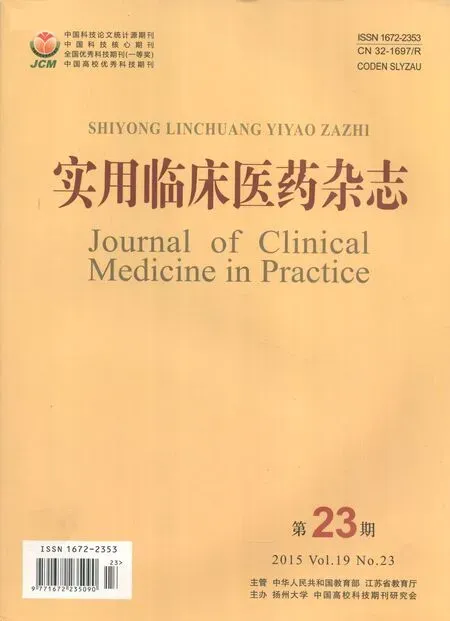膜联蛋白A1与炎症、肿瘤、纤维化关联的研究综述
膜联蛋白A1与炎症、肿瘤、纤维化关联的研究综述
张思慧1,2, 黄俊星1, 韩高华1
(1. 江苏省泰州市人民医院, 江苏 泰州, 225300; 2. 南通大学医学院, 江苏 南通, 226001)
关键词:膜联蛋白A1; 炎症; 肿瘤; 纤维化
膜联蛋白A1(ANXA1)属于Annexis家族中第一个被发现的蛋白,其开始被认为是糖皮质激素调节的磷脂酶A2抑制蛋白,随后被认为是应激蛋白在增殖、分化、凋亡中起作用[1]。近年来,ANXA1的一些研究涉及到了许多疾病,研究较多的是炎症和肿瘤。同时ANXA1与相应疾病的研究也扩展到抗纤维化、丙肝病毒的调节[2]、肌营养不良膜修复作用[3]等。现综述目前ANXA1在炎症、肿瘤、纤维化这3个方面的一些研究进展,以期对相应的疾病治疗与诊断有所帮助。
1ANXA1的介绍
膜联蛋白超家族的蛋白普遍在结构上具有高度同源性,拥有相同的核心结构,这个核心结构由4个同源结构域构成,能与钙离子结合使膜联蛋白经历构象变化[4]。然而,家族每个成员都有其独特的N末端,N末端结构关系着每个成员不同的功能与生理作用[5]。全长的ANXA1蛋白水解后将N末端断开,N段的26个氨基酸形成的一个肽链片段Ac2-26[6]。ANXA1和Ac2-26都能激活并结合特定G蛋白偶联受体(GPCR),此受体称为N-甲酰肽受体2(FPR2/ALX)[7],同时肽Ac2-26还能够与FPR1结合,而全长的ANXA1只能特异地与FPR2/ALX结合[8]。ANXA1的N末端的肽发挥着全长ANXA1的许多作用,但增加了抵抗裂解灭活蛋白酶3或中性粒细胞弹性蛋白酶[9]。ANXA1的N末端的结构域也因为其本身的特性成为整个分子的“热点”。
对膜联蛋白A1最初的认识是在1979年作为糖皮质激素调节蛋白,ANXA1在糖皮质激素动员花生四烯酸及其产物的过程中起抑制作用[5]。在人类静止的中性粒细胞,AnxA1大量存在于细胞质,只有一小部分出现在中性粒细胞表面。中性粒细胞激活后,AnxA1迅速动员到细胞表面,与相应的受体结合[10],从而发挥着生理功能。ANXA1参与多种生理过程,如细胞增殖、细胞分化、细胞信号转导、细胞凋亡、细胞免疫等。
2AXNA1与炎症
ANXA1是糖皮质激素调节蛋白,具有强抗炎和前消散作用[8]。AXA1限制了炎症的初始步骤,特别是白细胞补充和炎症介质产生。在炎症消退期,它也可通过诱导中性粒细胞凋亡[11]和增加巨噬细胞的胞葬作用[12]。除此之外,ANXA1还可以减少中性粒细胞对内皮黏附与跨内皮迁移[12],促进巨噬细胞分泌的抗炎细胞因子白细胞介素-10[13],抑制磷脂酶A2的激活,下调炎性花生酸的合成[14]。Girol等[15]研究发现,在小鼠的眼部组织和体外ARPE-19 细胞中,全长的ANXA1和AC2-26可以减轻由内毒素引起的眼部炎症。在小鼠的胸膜炎中,ANXA1和AC2-26通过诱导中性粒细胞凋亡来控制炎症[11]。ANXA1在热引起的炎性应激反应起到保护作用,保护细胞在应激过程中免受潜在炎症损伤[16]。Fulvio[17]提出了另一种观点,认为ANXA1是有促进炎症作用的,他认为ANXA1促进炎症体现在加速T细胞增殖,促进其向Th1分化[18],同时ANXA1对树突状细胞激活与分化[19],成纤维细胞的扩充与分化都起着刺激作用[17]。
近年来对ANXA1的抗炎的研究侧重于ANXA1衍生肽的发展。如在各种动物模型中AnxA12-50能更好地选择与FPR2/ALXR结合,从而有较好的抗炎和前消散效果[9]。当AC2-26和胶原Ⅳ及特异的纳米颗粒结合起来,Ac2-26的抗炎能力进一步增强,此结合物在酵母多糖导致的腹膜炎的小鼠模型中得到进一步验证[20]。此外,Perretti等[9]通过室内实验已经生成了代谢耦合稳定的CR-AnxA12-5肽,这种肽通过人的蛋白
酶3来耐受中性粒细胞对其的降解,限制中性粒细胞和内皮细胞的交互作用,增强中性粒细胞凋亡和巨噬细胞吞噬作用。在一系列炎症条件下,ANXA1系统代表了一个创新的治疗方法[17,21-22]。
3ANXA1与肿瘤
ANXA1失调已在多个肿瘤研究[23]中报道,表明这种蛋白质可能在肿瘤发展和进展中扮演了一个重要角色。ANXA1表达的缺失已被观察到在乳腺癌、胃癌、食管癌、前列腺癌、膀胱癌、头颈部肿瘤、喉癌、口腔癌,并与肿瘤的发生和恶性倾向相关[24]。而在肺癌、乳腺癌、胰腺癌、宫颈癌、膀胱癌、肾癌和垂体瘤可以发现ANXA1表达上调[24]。可以看到在乳腺癌和膀胱癌中,ANXA1表达是相互矛盾的,目前还无法解释[24]。无论是表达的上调或缺失,预示着ANXA1在将来可作为诊断某些癌症的标志因子。最近的一项研究[25]表明,在甲状腺肿瘤中,ANXA1联合S100A6和S100A11可以用于区别滤泡状癌和乳头状癌。在另一方面,许多研究[26]已证实ANXA1和肿瘤的发生、侵袭性和转移间的有关联。ANXA1可能通过NF-κB调控乳腺癌并增加转移潜能。也有报道指出ANXA1在乳腺癌中通过增强TGF-β/Smad信号通路从而促进转移形成[27]。最近的一项研究[28]中,在体外培养MDA-MB-231细胞,此细胞株为三阴性乳腺癌细胞且高表达ANXA1,后用siRNA敲除ANXA1后发现细胞的侵袭性下降,这提示在三阴的乳腺癌细胞中上调ANXA1促进细胞侵袭。而在喉鳞状细胞癌体内体外实验中,ANXA1通过旁分泌机制与FPR/ALX介导的肿瘤生长和转移[29]。此类研究结果表明,ANXA1可能成为治疗恶性疾病的潜在治疗靶点。然而在多形性胶质母细胞瘤患者中ANXA1基因表达水平与总生存率呈负相关[30],这提示ANXA1可以作为此类肿瘤患者的预后指标。同样,也有相关研究指出就目前而言,ANXA1在肿瘤方面的研究取得了一定的成效,但还存在一些矛盾之处,需要更多合理的实验来深入研究其中的相关机制。
4ANXA1与纤维化
Yuan等[31]通过观察建立大鼠的单侧输尿管梗阻模型,从而得出肾小管上皮中ANXA1异常高表达,考虑ANXA1是肾纤维化的潜在标志物。ANXA1不仅可能是纤维化潜在的标志物,还参与成纤维细胞的调节。PG Trentin等用IL-13和TGF-β刺激原代培养的成纤维细胞后再加入AC2-26,观察到成纤维细胞分泌的胶原和CCL2/MCP-1降低了,且表现为剂量依赖性,而成纤维细胞的增殖却没有变化。进一步研究出来自Fpr1 受体敲除小鼠的成纤维细胞被刺激后再接受肽Ac2-26,胶原蛋白和CCL2/MCP-1生产没有减少。相比之下, 来自Fpr2受体敲除小鼠的成纤维细胞接受肽Ac2-26后,CCL2/MCP-1的产生得到抑制,胶原蛋白的产生没有抑制。这些结果表明Fpr1和Fpr2受体通过肽Ac2-26间接活化肺成纤维细胞。然而,似乎仅有Fpr1受体抑制CCL2/MCP-1的生产。这清楚地表明,肽Ac2-26有不同的机制下调肺成纤维细胞活化[32]。同样, Damazo等[33]的研究也得出了类似的结论,ANXA1的下调可能是肺纤维化发展的重要决定因素。还有研究[34]表明AnxA1 mRNA水平与非酒精性脂肪肝患者肝纤维化的严重程度负相关。
ANXA1从第一次发现至今已经有30多年,研究成果丰富。ANXA1在炎症方面主要还是抗炎作用;在肿瘤方面,ANXA1在诊断与预后方面因肿瘤类型各有差异,而ANXA1在肿瘤生长和转移的参与为肿瘤潜在的治疗靶点提供了相应的依据,然而还需进一步深入地研究解决目前的矛盾与未知;ANXA1在纤维化方面研究尚不多,但主流的观点还是抗纤维化作用。期待ANXA1的研究在未来有更多发现。
参考文献
[1]Lim L H, Pervaiz S. Annexin 1: the new face of an old molecule[J]. FASEB J, 2007, 21(4): 968.
[2]Hiramoto H, Dansako H, Takeda M, et al. Annexin A1 negatively regulates viral RNA replication of hepatitis C virus[J]. Acta Med Okayama, 2015, 69(2): 71.
[3]Shimizu-Motohashi Y, Asakura Y, Motohashi N, et al. Pregnancy-induced amelioration of muscular dystrophy phenotype in mdx mice via muscle membrane stabilization effect of glucocorticoid[J]. PLoS One, 2015, 10(3): e120325.
[4]Perretti M, Dalli J. Exploiting the Annexin A1 pathway for the development of novel anti-inflammatory therapeutics[J]. Br J Pharmacol, 2009, 158(4): 936.
[5]Yazid S, Norling L V, Flower R J. Anti-inflammatory drugs, eicosanoids and the annexin A1/FPR2 anti-inflammatory system[J]. Prostaglandins Other Lipid Mediat, 2012, 98(3/4): 94.
[6]Dalli J, Montero-Melendez T, Mcarthur S, et al. Annexin A1 N-terminal derived Peptide ac2-26 exerts chemokinetic effects on human neutrophils[J]. Front Pharmacol, 2012, 3: 28.
[7]Cooray S N, Gobbetti T, Montero-Melendez T, et al. Ligand-specific conformational change of the G-protein-coupled receptor ALX/FPR2 determines proresolving functional responses[J]. Proc Natl Acad Sci U S A, 2013, 110(45): 18232.
[8]Hayhoe R P, Kamal A M, Solito E, et al. Annexin 1 and its bioactive peptide inhibit neutrophil-endothelium interactions under flow: indication of distinct receptor involvement[J]. Blood, 2006,107(5): 2123.
[9]Dalli J, Consalvo A P, Ray V, et al. Proresolving and tissue-protective actions of annexin A1-based cleavage-resistant peptides are mediated by formyl peptide receptor 2/lipoxin A4 receptor[J]. J Immunol, 2013, 190(12): 6478.
[10]Perretti M, Chiang N, La M, et al. Endogenous lipid- and peptide-derived anti-inflammatory pathways generated with glucocorticoid and aspirin treatment activate the lipoxin A4 receptor[J]. Nat Med, 2002, 8(11): 1296.
[11]Vago J P, Nogueira C R, Tavares L P, et al. Annexin A1 modulates natural and glucocorticoid-induced resolution of inflammation by enhancing neutrophil apoptosis[J]. J Leukoc Biol, 2012, 92(2): 249.
[12]Dalli J, Jones C P, Cavalcanti D M, et al. Annexin A1 regulates neutrophil clearance by macrophages in the mouse bone marrow[J]. FASEB J, 2012, 26(1): 387.
[13]Da C E, Oliani S M, Damazo A S. Effect of annexin-A1 peptide treatment during lung inflammation induced by lipopolysaccharide[J]. Pulm Pharmacol Ther, 2012, 25(4): 303.
[14]Kwon J H, Lee J H, Kim K S, et al. Regulation of cytosolic phospholipase A2 phosphorylation by proteolytic cleavage of annexin A1 in activated mast cells[J]. J Immunol, 2012, 188(11): 5665.
[15]Girol A P, Mimura K K, Drewes C C, et al. Anti-inflammatory mechanisms of the annexin A1 protein and its mimetic peptide Ac2-26 in models of ocular inflammation in vivo and in vitro[J]. J Immunol, 2013, 190(11): 5689.
[16]Nair S, Arora S, Lim J Y, et al. The regulation of TNFalpha production after heat and endotoxin stimulation is dependent on Annexin-A1 and HSP70[J]. Cell Stress Chaperones, 2015, 20(4): 583.
[17]D′Acquisto F, Piras G, Rattazzi L. Pro-inflammatory and pathogenic properties of Annexin-A1: the whole is greater than the sum of its parts[J]. Biochem Pharmacol, 2013, 85(9): 1213.
[18]D′Acquisto F, Merghani A, Lecona E, et al. Annexin-1 modulates T-cell activation and differentiation[J]. Blood, 2007, 109(3): 1095.
[19]Huggins A, Paschalidis N, Flower R J, et al. Annexin-1-deficient dendritic cells acquire a mature phenotype during differentiation[J]. FASEB J, 2009, 23(4): 985.
[20]Kamaly N, Fredman G, Subramanian M, et al. Development and in vivo efficacy of targeted polymeric inflammation-resolving nanoparticles[J]. Proc Natl Acad Sci U S A, 2013, 110(16): 6506.
[21]Alessandri A L, Sousa L P, Lucas C D, et al. Resolution of inflammation: mechanisms and opportunity for drug development[J]. Pharmacol Ther, 2013, 139(2): 189.
[22]Sousa L P, Alessandri A L, Pinho V, et al. Pharmacological strategies to resolve acute inflammation[J]. Curr Opin Pharmacol, 2013, 13(4): 625.
[23]Jorge Y C, Mataruco M M, Araujo L P, et al. Expression of annexin-A1 and galectin-1 anti-inflammatory proteins and mRNA in chronic gastritis and gastric cancer[J]. Mediators Inflamm, 2013, 2013: 152860.
[24]Biaoxue R, Xiguang C, Shuanying Y. Annexin A1 in malignant tumors: current opinions and controversies[J]. Int J Biol Markers, 2014, 29(1): e8.
[25]Martinez-Aguilar J, Clifton-Bligh R, Molloy M P. A multiplexed, targeted mass spectrometry assay of the S100 protein family uncovers the isoform-specific expression in thyroid tumours[J]. BMC Cancer, 2015, 15: 199.
[26]Bist P, Leow S C, Phua Q H, et al. Annexin-1 interacts with NEMO and RIP1 to constitutively activate IKK complex and NF-kappaB: implication in breast cancer metastasis[J]. Oncogene, 2011, 30(28): 3174.
[27]de Graauw M, van Miltenburg M H, Schmidt M K, et al. Annexin A1 regulates TGF-beta signaling and promotes metastasis formation of basal-like breast cancer cells[J]. Proc Natl Acad Sci U S A, 2010, 107(14): 6340.
[28]Okano M, Kumamoto K, Saito M, et al. Upregulated Annexin A1 promotes cellular invasion in triple-negative breast cancer[J]. Oncol Rep, 2015, 33(3): 1064.
[29]Gastardelo T S, Cunha B R, Raposo L S, et al. Inflammation and cancer: role of annexin A1 and FPR2/ALX in proliferation and metastasis in human laryngeal squamous cell carcinoma[J]. PLoS One, 2014, 9(12): e111317.
[30]Mallawaaratchy D M, Buckland M E, Mcdonald K L, et al. Membrane proteome analysis of glioblastoma cell invasion[J]. J Neuropathol Exp Neurol, 2015, 74(5): 425.
[31]Yuan Y, Zhang F, Wu J, et al. Urinary candidate biomarker discovery in a rat unilateral ureteral obstruction model[J]. Sci Rep, 2015, 5: 9314.
[32]Trentin P G, Ferreira T P, Arantes A C, et al. Annexin A1 mimetic peptide controls the inflammatory and fibrotic effects of silica particles in mice[J]. Br J Pharmacol, 2015: 231.
[33]Damazo A S, Sampaio A L, Nakata C M, et al. Endogenous annexin A1 counter-regulates bleomycin-induced lung fibrosis[J]. BMC Immunol, 2011, 12: 59.
[34]Locatelli I, Sutti S, Jindal A, et al. Endogenous annexin A1 is a novel protective determinant in nonalcoholic steatohepatitis in mice[J]. Hepatology, 2014, 60(2): 531.
收稿日期:2015-05-27
中图分类号:R 73
文献标志码:A
文章编号:1672-2353(2015)23-240-03DOI: 10.7619/jcmp.201523098

